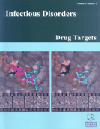- Home
- A-Z Publications
- Infectious Disorders - Drug Targets (Formerly Current Drug Targets - Infectious Disorders)
- Previous Issues
- Volume 10, Issue 5, 2010
Infectious Disorders - Drug Targets (Formerly Current Drug Targets - Infectious Disorders) - Volume 10, Issue 5, 2010
Volume 10, Issue 5, 2010
-
-
Editorial [Hot topic: Food-Borne Parasites and the Relevant Therapeutic Targets (Guest Editor: Nikolai A. Shevchuk)]
More LessInfections caused by food-borne parasites continue to be a serious public health problem, especially in the developing world. In the industrial countries, this kind of illnesses are not uncommon in the segment of population who adhere to fad diets containing raw flesh and in cultures where dishes made of raw fish or meat are a long-standing tradition. It is believed that the most effective solution to this problem lies in educat Read More
-
-
-
A Glance at Taenia Saginata Infection, Diagnosis, Vaccine, Biological Control and Treatment
More LessAuthors: Claudio V. Silva and Julia M. Costa-CruzThe Taenia saginata taeniasis-cysticercosis complex is a cosmopolitan zoonosis of great medical, veterinary and economic importance where humans play an important role as the carrier of adult stage and cattle as carrier of the larval stage of the parasite. Here we reviewed aspects concerning diagnosis, vaccine development, biological control and treatment of the disease.
-
-
-
Drug Target in Eosinophilic Meningitis Caused by Angiostrongylus cantonensis
More LessAuthors: Kittisak Sawanyawisuth and Kanlayanee SawanyawisuthEosinophilic meningitis caused by Angiostrongylus cantonensis is an emerging infectious disease. It is the most common form of human angiostrongyliasis. The diagnosis is made by clinical criteria including the presence of cerebrospinal fluid eosinophils and a history of exposure to A. cantonensis larvae, e.g., from raw freshwater snails or contaminated vegetables. Among various treatment options, corticosteroid is the Read More
-
-
-
Giardiasis: The Ever-Present Threat of a Neglected Disease
More LessAlthough giardiasis has been a threat to mankind for thousands of years, this protozoan infection was, until recently, relatively neglected. Giardia duodenalis is recognised as a major cause of parasite-induced diarrhoea in humans and animals, and is currently an important public health problem, placing a heavy burden on both diagnostic and treatment services at health care institutions, mostly in developing countries, b Read More
-
-
-
Ascaris lumbricoides: An Overview of Therapeutic Targets
More LessAuthors: Isabel Hagel and Tatiana GiustiA. lumbricoides is the largest of the common nematode parasites of man and has been associated with intestinal pathology, respiratory symptoms and malnutrition in children from endemic areas. Current anthelmintic treatments have proven to be safe. However, a reduced efficacy of single dose drugs has been reported. In veterinary practice, anthelmintic drug resistance is an irreversible problem. Thus, research and develo Read More
-
-
-
Cyclospora Cayetanensis: A Review, Focusing on What Some of the Remaining Questions about Cyclosporiasis
More LessCyclosporiasis is a protracted, relapsing gastroenteritis and has a short recorded history. Cyclospora cayetanensis is an enigmatic parasite since its discovery highlights the need for isolation of cases of infection that could be part of widespread outbreaks. It is associated with diarrhoea among children in developing countries in the Americas, where C. cayetanensis is endemic; traveller's diarrhoea and/or food and waterborne ou Read More
-
-
-
Trichinella spiralis: Genomic Application to Control a Zoonotic Nematode
More LessAuthors: Makedonka Mitreva and Douglas P. JasmerThe nematode Trichinella spiralis and related species are zoonotic food-borne pathogens of humans. The muscle larval stage of this parasite establishes a chronic infection in skeletal muscle cells of humans who acquire trichinellosis. Muscle larvae also reside in skeletal muscles of animals, swine in particular, and other food animals, including game animals. These muscle larvae are the source of zoonotic transmission to hu Read More
-
-
-
The Digenea Parasite Opisthorchis felineus: A Target for the Discovery and Development of Novel Drugs
More LessAuthors: Viatcheslav A. Mordvinov and Dagmara P. FurmanOpisthorchosis is a helminthiasis affecting mainly the hepatobiliary system and pancreas; its most dramatic complication is malignization of the organs infected by the parasites. The causative agents of opisthorchosis are two species of liver flukes, the trematodes belonging to the family Opisthorchiidae—Opisthorchis felineus and O. viverrini. The Chinese liver fluke, Clonorchis sinensis, also member of the family Opisthorc Read More
-
-
-
Opisthorchiidosis-A Review
More LessThe discovery history of opisthorchiid flukes dates back more than 200 years. The life cycle of these liver flukes includes prosobranch snails as the first and a big variety of freshwater fish as the second intermediate hosts. Opisthorchis felineus, O. viverrini and Clonorchis sinensis are species of major medical importance, while sporadic cases of human infection with other representatives of this family are also documented in the Read More
-
Volumes & issues
-
Volume 25 (2025)
-
Volume 24 (2024)
-
Volume 23 (2023)
-
Volume 22 (2022)
-
Volume 21 (2021)
-
Volume 20 (2020)
-
Volume 19 (2019)
-
Volume 18 (2018)
-
Volume 17 (2017)
-
Volume 16 (2016)
-
Volume 15 (2015)
-
Volume 14 (2014)
-
Volume 13 (2013)
-
Volume 12 (2012)
-
Volume 11 (2011)
-
Volume 10 (2010)
-
Volume 9 (2009)
-
Volume 8 (2008)
-
Volume 7 (2007)
-
Volume 6 (2006)
Most Read This Month
Article
content/journals/iddt
Journal
10
5
false
en


